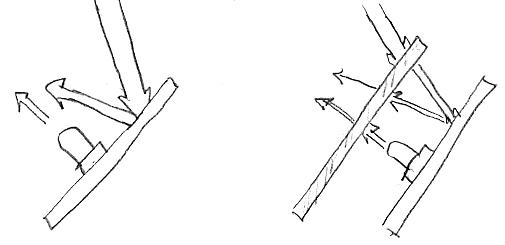"I did some experiments on this with the tuner back before I built my current theremin. I have a sample book of Roscolux Cinegel color filters that I tried with various combinations..." - pitts8rh
OK, I'm seriously in awe of your scientific method! All I've done in this regard is to just get a few samples of various gray acrylic sheet material from a "cutter" on eBay. IIRC the Lexan Margard MR10 Solar Gray seemed like the best fit for the LCD, but perhaps not quite dark enough for the LEDs (it seems to be a 50% transmission neutral filter?). It's probably too much of a tradeoff to do both LCD and LEDs with the same filter? Seems that way anyway with my minimal impromptu testing.
"For filters matching the color of the the LEDs, the percent transmission can be chosen to be low enough to just sufficiently blacken the background (benefited by 2-way light attenuation) while losing very little of what you want to see due to the one-way reduction of the in-band LED color. Reducing the transmission % any further beyond this will then reduce contrast, which is generally not what you want."
Was there a ballpark % transmission for monochromatic LEDs that seemed to work best?
"The octave 7-segment display on my tuner has blue film overlay, and I may have applied an overlay to the tuner that I built for you (or I intended to)."
Yes, I noticed the red film overlay right away when I received it, I had no idea that you applied it though - thanks!
"I like blue myself, but for a tuner with closely spaced LEDs or one set some distance away (separate like mine) it is not the best color due to the eye's inability to focus and resolve very well at that end of the spectrum."
Very good points. Blue can be kind a fuzzy looking. Green then? I actually really like the white note LEDs on my tuner - we need a white filter! :-)
"I don't see any great benefit to filtering the LCD unless you like the stealth look. And if you want the LCD to be a different color, it would be better to use a different backlight color."
Agree. You can maybe get it with an RGB backlight, then pick the color you want after the fact. I feel a little bad I don't have a way to control the backlight brightness - but I can't imagine ever wanting to turn it down, it's not like it's burning holes in my retina or anything.
Exposed LEDs - through holes in the panel as you do - are actually already more or less filtered with their colored milky plastic cases. And there's a real value in being able to see the positions of the dark ones, as the overall pattern is something the eye can key off of.
I also agree on the value of different colors for the volume and note displays, particularly if viewed at a distance.



